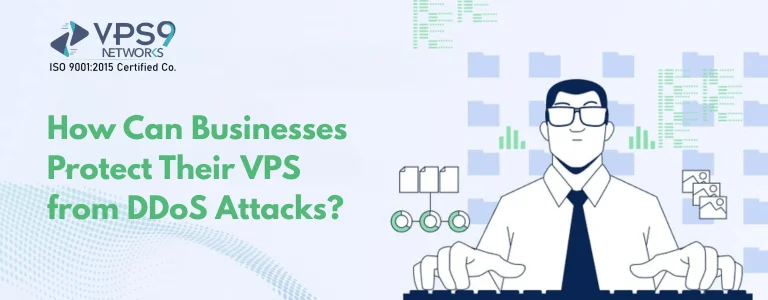Introduction
What is a DDoS Attack?
Why Are VPS Targeted by DDoS Attacks?
Common Types of DDoS Attacks
Impact of DDoS Attacks on VPS and Business Operations
In today’s global marketplace, the internet is crucial for business, customer interaction, and revenue. Virtual Private Servers (VPS) offer an effective and affordable solution for hosting critical applications and websites. However, VPS hosting introduces inherent security challenges, particularly from DDoS (Distributed Denial-of-Service) attacks, which can lead to service disruption, reputational damage, and revenue loss.
This blog discusses what businesses can do to secure their VPS from DDoS attacks through the implementation of a variety of plans that can help minimise risk and provide uninterrupted and reliable service to their customers.

A DDoS attack takes place when many compromised computers (typically botnets) target a server with massive amounts of internet traffic. The goal is to exhaust the server’s resources—like bandwidth or processing power—until it can no longer respond to legitimate requests, causing it to become unresponsive or go offline. These attacks are challenging to mitigate because they often use high volumes of legitimate-looking traffic to overwhelm the server, making it difficult to distinguish between real users and attackers.
The accessible nature of VPS hosting makes it a common target for DDoS attacks. VPS provides organizations with greater access to server resources than shared hosting; however, VPS hosting infrastructure is available to the public (even if secured, but this doesn’t guarantee immunity from malicious actions). VPS servers are a great target for attacks since they’re home to key business services, making them vital for daily operations. Attackers often exploit misconfigured VPS settings or use scraper bots to generate automated requests, making them ideal targets for inducing downtime via DDoS.
Before discussing protection methods, we must understand the most common forms of DDoS attacks. These attacks differ in their volume and complexity, but they all share the same purpose: to overwhelm the target’s resources.
Volume-Based Attacks: Volume-based attacks target your intended system by flooding it with traffic, resulting in significant bandwidth consumption and the eventual crashing of your servers. The most common examples are UDP floods and ICMP floods.
Protocol Attacks: Protocol attacks exploit certain vulnerabilities found in protocol stacks, commonly used by servers like TCP or HTTP flood. These attacks exhaust server resources (like connection tables), preventing the server from recovering. The most common examples are SYN floods, and Ping of Death.
Application Layer Attacks: Application attacks target specific applications, and overwhelm the server with a high volume of seemingly legitimate requests (e.g., HTTP floods), causing severe performance degradation or outage. An example of such an attack would be an HTTP flood.

The consequences of a DDoS attack will vary in severity depending on the extent of the attack and how long it lasts. Here are some possible consequences of a DDoS attack:
- Server Downtime: A DDoS attack can take your server down or make it unresponsive, which would result in your website and services being unavailable to your customers.
- Loss of Revenue: If a VPS hosts an online store or service, downtime means the loss of sales, subscriptions, or other sources of revenue.
- Reputation Damage: Continuous or prolonged outages can erode customer trust and damage your reputation.
- Data Loss: In some situations, the attack can be followed by other malicious behavior that results in corrupted or stolen data
Given these severe consequences, it is critical for organizations to implement robust measures to mitigate DDoS risks.
How Can Businesses Protect Their VPS from DDoS Attacks?
- 6.1. Use a Content Delivery Network (CDN)
- 6.2. Employ a DDoS Mitigation Service
- 6.3. Configure Firewalls for DDoS Protection
- 6.4. Implement Intrusion Detection and Prevention Systems (IDPS)
- 6.5. Utilize Load Balancing
- 6.6. Apply Rate Limiting
- 6.7. Keep Your VPS Updated
- 6.8. Monitor Traffic and Set Alerts
Below are the most effective strategies businesses can employ to protect their VPS from DDoS attacks:
A CDN is a series of servers distributed over different geographical locations. CDNs may help against DDoS attacks by distributing the content to the end-user’s location. CDNs also help offload your VPS from being the only server accepting the heavy traffic as a result of a DDoS attack. A CDN ensures your end-users can access content even during an attack. CDN’s often provide DDoS protection, allowing businesses to absorb and mitigate against large attacks.
DDoS mitigation services are specialized solutions capable of identifying and mitigating DDoS attacks in real time. These services look over incoming traffic, eliminate malicious requests, and pass legitimate traffic to your server. A few examples of DDoS protection services are Cloudflare, Akamai Kona Site Defender, and Arbor Networks.
These services absorb and filter attacks before they reach your VPS, which keeps the server up and running during an attack.
Firewalls can be effective in protecting VPS against DDoS attacks. Configuring firewall rules to block suspicious traffic will greatly lower the chances of a successful attack. Some firewalls already include DDoS-protection features, like rate limiting and access control lists. Additionally, configure firewalls to block specific attack vectors like ICMP floods or restrict IP addresses demonstrating anomalous behaviour.
An Intrusion Detection and Prevention System (IDPS) monitors your network traffic for indications of malicious activity and takes action to block probable threats. An IDPS can facilitate identifying DDoS attacks in their infancy, and in most cases, cut and block traffic from identified malicious IPs or known bots. IDPS provides an additional layer of defense against malicious attacks.
IDPS provides actionable data that can elaborate patterns of traffic and display unwanted behavior. IDPS can limit DDoS attacks from reaching your VPS, which will inadvertently mitigate service disruptions.
Load balancing allows us to manage incoming traffic across multiple servers so that an individual server does not get overwhelmed with traffic. In the case of a DDoS attack, your load balancer can route the traffic to secondary servers or absorb the traffic into an extended network, which will increase the overall capacity of your VPS and avoid overload. By distributing requests across a scalable infrastructure, load balancers significantly reduce potential downtime from a DDoS attack.
Rate limiting is a method to manage how many requests a server will accept from an IP address in a time frame. Rate limiting enables businesses to reduce the ability of automated DDoS bots to overload servers with excessive requests.
Rate limiting can occur at several levels; application level, network level, and server level, to give businesses the flexibility to minimize the effect of an attack.
Keeping your VPS updated is important for security reasons. By updating the operating system, server software, and security patches, you ensure that your server is not affected by previously discovered exploits that could be used during a DDoS attack. Attackers often target security weaknesses in outdated software. You can minimize these risks by updating your software regularly.
Updates also tend to have improvements in performance that will help your server cope with traffic volume.
Keeping watch on your VPSVPS traffic can help you detect and mitigate DDoS attacks before large-scale damage occurs. Monitoring tools let you observe spikes, or sudden amounts of traffic that are abnormal, from a specific IP range or geographic area. Using alerts for irregular traffic, businesses can respond quickly to limit the attack before it escalates.

Best Practices for Long-Term DDoS Protection
Although taking quick steps to establish immediate protection is important, businesses should take a long-term approach against DDoS attacks. A comprehensive security plan should include an incident response strategy, regular defense testing, and collaboration with your hosting provider to enhance security measures. Educating employees on DDoS threats and proper responses to those threats will help streamline both speed and coordination when responding to an attack.
Conclusion
DDoS attacks pose a significant threat to businesses using VPS hosting. However, a multi-layered defense strategy—incorporating CDNs, DDoS mitigation services, firewalls, and load balancers—can effectively protect VPS infrastructure from outages. Keeping vigilant, maintaining updates, and taking a multi-faceted approach, VPS-hosted organizations can protect their online services and remain consistent for customers.



